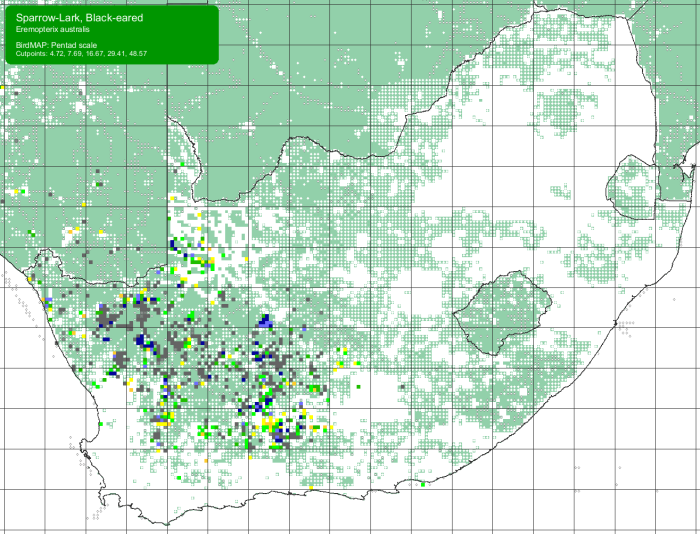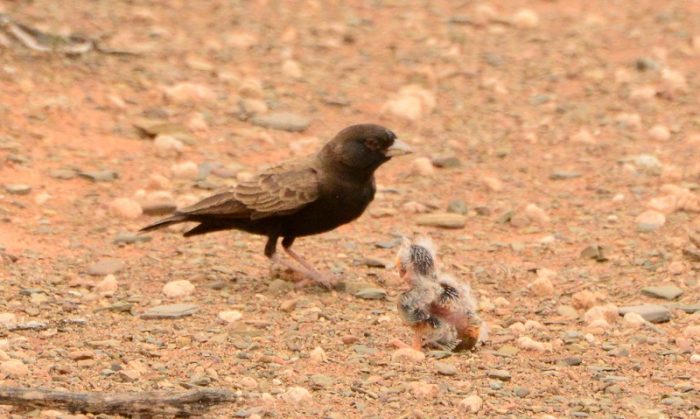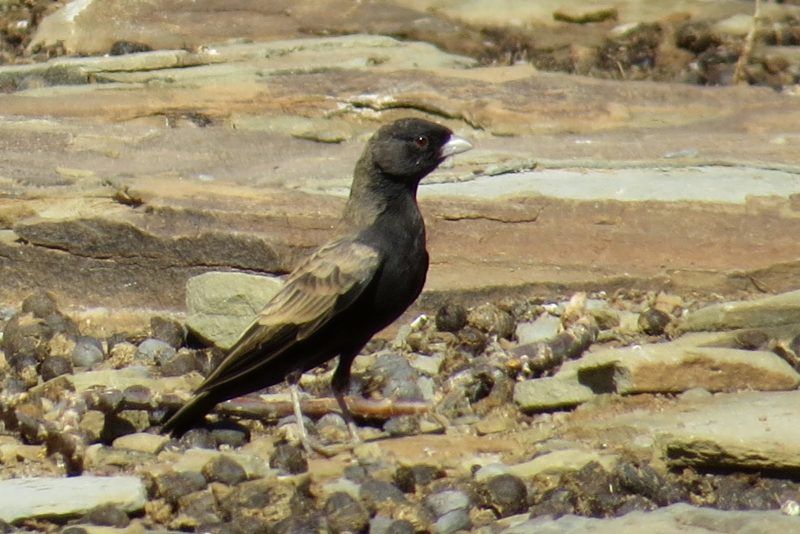Cover image: Black-eared Sparrow-lark by Alan Collett – Carnarvon District, Northern Cape – BirdPix No. 70664
Identification
The Black-eared Sparrow-lark is a small, compact lark with a conical grey-white beak. The species shows marked sexual dimorphism.
Adult males are unmistakable, being entirely black save for chestnut brown feathers on the back, wings and upper-tail. Pitch-black underwings render males very conspicuous in flight.

Photo by Ryan Tippett
Females are pale brown above on the back and wings. The undersides are cream-coloured, with heavy but variable black streaks. The streaks are predominantly on the chest but may extend onto the belly. Lacks the dark belly patch of other sparrow-lark females. In flight shows distinctive black secondaries.
Immature birds resemble the females but are variably buff and white spotted above.

Photo by Tino Herselman
Status and Distribution
The Black-eared Sparrow-lark is endemic to Southern Africa. It occurs mainly in southern Namibia and the Northern Cape in South Africa. It is marginal in the Western Cape, Eastern Cape and Free State and its its presence in these provinces can be erratic.
It is most numerous in the central and upper Karoo of the Northern Cape.

Details for map interpretation can be found here.
Habitat
Occurs in arid, sparse shrublands and grassland, particularly on red soils. Favours sandy soil but is also found on poorly drained clays and stony substrates in the Karoo. The Black-eared Sparrow-lark is also present in the southern Kalahari.

Carnarvon District, Northern Cape
Photo by Ryan Tippett
Behaviour
Gregarious at all times, even when breeding and flocks usually number 5 to 10 birds. Flock sizes swell after breeding and can range from 50 to several hundred birds. Aggregates in large numbers in areas receiving good rainfall.
Forages in open places among shrubs and stones. Flies readily when disturbed, in typically bouncing erratic flight. Males perform a circular, butterfly-like display flight with exaggerated wingbeats and sometimes with dangling legs.

Black-eared Sparrow-lark (Eremopterix australis) – Carnarvon District, Northern Cape
Photo by Ryan Tippett
Collects food items off the ground or from the base of plants. The diet consists of various insects and a wide range of seeds. Favours grass seeds but also consumes the seeds of forbs and shrubs. Insect prey is known to include termites, beetles, ants and leaf-hoppers. Very seldom drinks and gets almost all its moisture requirement from the food it eats (Metabolic water).

Photo by Vaughan Jessnitz
The Black-eared Sparrow-lark is a monogamous, territorial and solitary nester, even though nests may only be a few meters apart. Breeding may take place at any time of the year and is linked to rainfall. They require at least 40 to 50mm of rainfall to stimulate widespread breeding.
The nest is a cup composed of fine grass leaves, panicles, feathery awns and rootlets. The nest is placed in an excavated hollow, usually in sandy substrate. The nest rim is normally slightly raised and decorated with the soil encrusted webs of Buckspoor Spiders (Seothyra spp.). The nest is usually situated at the base of a shrub or grass tuft and facing south or east for shade. The nest is built entirely by the female.
1 to 4 (normally 2 or 3) eggs are laid per clutch. Clutches are largest after heavy or follow-up rainfall. The eggs are white and finely speckled with pinkish-brown markings. The markings are often concentrated at the obtuse end. Incubation begins after all the eggs have been laid and is shared equally between the sexes.
The nestling period lasts just 7 to 10 days and parental duties are shared by both sexes. The young are fed exclusively on arthropods, particularly Harvester Termites, caterpillars and grasshoppers. The adults perform distraction displays when the eggs or young are threatened. The male will hover over the nest while alarm calling. Both sexes perform an injury-feigning display by flying towards an intruder with loud wing-beats, before dropping to the ground and fluttering away while giving distress calls.

Photo by Ryan Tippett
Further Resources
Species text adapted from the first Southern African Bird Atlas Project (SABAP1), 1997.
The use of photographs by Alan Collett, Gerald Wingate, Tino Herselman and Vaughan Jessnitz is acknowledged.
Virtual Museum (BirdPix > Search VM > By Scientific or Common Name).
Other common names: Swartoorlewerik (Afrikaans); Moinelette à oreillons noirs (French); Schwarzwangenlerche (German); Cotovia-pardal-preta (Portuguese)
Recommended citation format: Tippett RM 2023. Black-eared Sparrow-lark (Eremopterix australis) Biodiversity and Development Institute. Available Online at http://thebdi.org/2023/02/04/black-eared-sparrow-lark-eremopterix-australis/

Photo by Gerald Wingate

